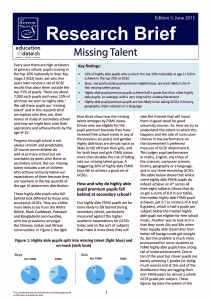Every year there are high achievers at primary school, pupils scoring in the top 10% nationally in their Key Stage 2 (KS2) tests, yet who five years later receive a set of GCSE results that place them outside the top 25% of pupils. There are about 7,000 such pupils each year, 15% of all those we term as highly able. We call these pupils our ‘missing talent’ and in this Sutton Trust research brief we explore who they are, their routes of study at secondary school and how we might best raise their aspirations and achievements by the age of 16.
The findings show that boys, particularly those from disadvantaged homes, are the most likely to be in this group of missing talent. Our analysis also suggests that schools are not ensuring highly able but poor children take a GCSE curriculum that leaves open the widest choice of options at age 16: they are less likely to be taking GCSEs in history, geography, triple sciences or a language. But there are many schools across the country that are exemplars of best practice in the education of highly able children and these schools could provide a programme of extra-curricular support to raise horizons and aspirations for children living in the wider area.
The report received widespread coverage in the press, including the BBC, Guardian, Independent, TES, Schools Week, Daily Mirror and Daily Mail. It has been cited in speeches by Secretary of State for Education, Nicky Morgan MP, Minister of State at the Department of Education, Nick Gibb MP.







Leave A Comment